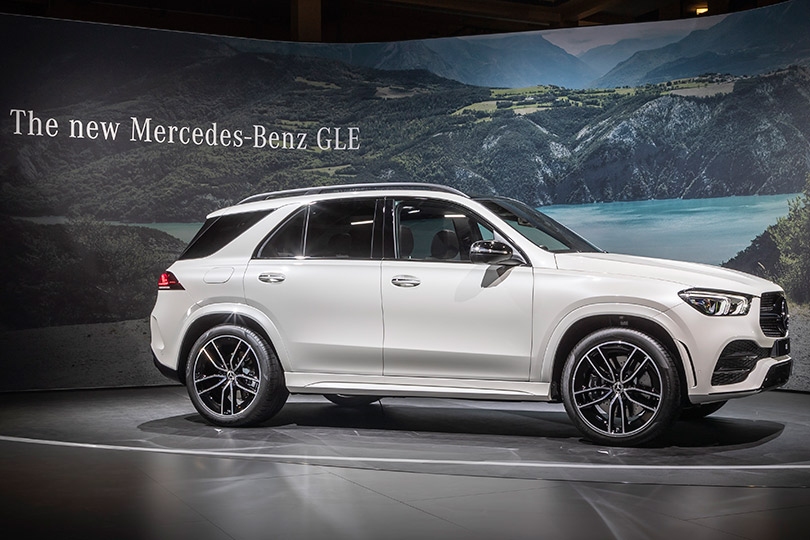As far as motor shows go, the Mondial de l’Automobile is a great one to visit. It’s in Paris, for a start, so you certainly won’t be bored before and after. It’s also just about the right size — not nearly as expansive as the one in Frankfurt but not miniaturized like the one in Geneva either. This year, Mercedes-Benz brought a huge amount of all-new cars to Paris, and I had the opportunity to sit down and talk with some of their executives too.
The new GLE
Probably the most interesting model for the Russian market is the new GLE. Mercedes-Benz don’t mind reminding us that they were the first brand into this SUV segment many, many moons ago, and the new GLE looks like a formidable effort in a pretty competitive market that includes cars like the BMW X5 and Audi Q7. The new GLE looks very pleasant to the eye, to the point that it even looks a little more compact than the previous model. The specifications, however, suggest that it has actually grown slightly. As a result, there is more even space inside than before.
But the biggest changes are technological in nature. The GLE 450, the only model which was shown on the Mercedes stand, comes with the turbocharged 3 liter inline 6 that I still remember from the new CLS launch back in March. It’s a very sweet engine, good for 362 horsepower, and the 48 Volt mild hybrid system does its part for reducing fuel consumption and emissions. More engine choices, including a plug-in hybrid version will follow at a later date. The new GLE also gets a more advanced 4Matic all-wheel-drive systems and a new E-Active Body Control System which can adjust the air suspension individually on each of the 4 corners of the car allowing it to “lean” into a sharp corner for better handling and increased passenger comfort.
![]()
A new baby AMG — the A35
It’s probably impossible to have too many AMG models, so we welcome the new entry-level AMG car with open arms. Of course, while it may be entry level in AMG terms, a 306 horsepower “hot hatch” built by a company of this stature is not going to be something to sniff at. Just looking at the size of the brakes on the A35 make it clear that this car is a lot more than just turning up the boost on the engine plus a badge job. The new model conveniently bridges the gap between the incredibly powerful Mercedes-AMG A45 and the next most powerful A class, the 190 horsepower A220.
I had a brief talk about the new car, and the future with Tobias Moers, CEO of Mercedes-AMG and probably the only executive on the show who could successfully pull off wearing a mean leather jacket to an interview.
![]()
Jan Coomans: Mercedes-AMG has recently begun offering two distinct performance levels for each of its models, very different from your competitors who refuse to stick their most famous badges on their second tier performance models. What is the reasoning behind AMG doing things differently, without worrying about diluting the brand?
Tobias Moers: To be honest I don’t really know what the others are up to exactly. But at AMG we have a lot of freedom within Mercedes-Benz to do things our way. The way we see it, expanding the AMG line is the best way to give customers the performance car they are looking for. For example now with the new AMG 35, we are offering customers an entry into the AMG brand from where they can perhaps grow into bigger models down the line. But we don’t dilute the brand. It would be very easy for us to just tune the engine a little bit and slap a badge on the trunk and call it a day, but that’s not what we do. We have dedicated hardware for every model when it comes to things like kinematics, steering, axles… everything is done at AMG. The A35 now already has components which it will share with the new A45 when that comes out next year. I would say that the new A35 is on the level of today’s A45, even though it has less horsepower.
But I strictly believe in the one brand approach. It’s Mercedes-AMG. All the way from the A35 up to the Project One.
— We already have AMG cars with a mild, low voltage, hybrid system. When can we expect models with a more potent hybrid system?
— From the end of 2020, every new program from us will be a hybrid. They will be purpose built performance hybrid systems, our own design which is rather different from the kind of system which will be used in regular Mercedes-Benz models. The battery, the drive unit, we develop everything. There is a trade-off with batteries where you have to decide whether you want maximum performance or maximum capacity, but our cars will still have a decent driving range on purely electric power alone.
![]()
— Do you think it might get more difficult in the electric future to differentiate the AMG models for the regular cars when all are using electric motors as opposed to large petrol engines that create a great sound?
— You know, I don’t think we can reduce the difference between our cars and regular models to only the engine. That was probably the case a long time ago when AMG’s were very fast in a straight line, and some competitors were better in the corners. That is no longer the case. We change the complete package of the car, the character, and the engine is just a part of that. We now talk about being a sports car competitor in our entire approach.
— Thank you very much, Mr. Moers!
The fully electric EQC
To keep things somewhat simple for us simple journalists and customers alike, all electric Mercedes-Benz cars follow under the EQ line. The obvious place to enter the EV market is the hugely popular mid-size SUV market, so the EQC falls neatly into that. The EQC 400 4Matic is the initial model, with an 80 kWh battery, less than 5 seconds to accelerate to 100 km/h and a claimed range of more than 400 kilometers. It will enter mass production in 2020, which still sounds quite far away but that time will, as usual, probably be here sooner than we think.
There will probably be more to this car than just specifications. With fully electric cars still in their infancy, the interesting times are starting now that some of the biggest and best car manufacturers are throwing their weight behind the technology. The difference between a good car and a bad one is most often found in the detailed calibration of the drivetrain and suspension systems plus the know-how in terms of build quality and efficiency of production. So I can’t wait to try the EQC when it comes out.
![]()
The new B-Class
Since we got a new A-Class not too long ago, it was rather logical that we’d get a new B-Class too. Not least because they share the same platform. Aside from new styling features, the B-Class packs new engines, new technology for autonomous driving and a new interior. The inside is probably where the biggest changes have been made, an all digital dashboard and infotainment system bringing the B-Class firmly up to contemporary Mercedes-Benz standards.
![]()
Concept car — EQ Silver Arrow
The original Silver Arrow, W125, was silver because painting its aluminium shell would add undesirable weight. This latest concept is very much painted, but it’s every bit as stunning looking. Of course it’s highly unlikely that we’ll ever see anything like this car being built, but this is your typical outrageous concept that is the stuff of dreams of would-be car designers when their age is still in the single digits. You can’t help but look at it and decide that the future can’t be that bad after all.
![]()
Talking with Jochen Hermann, head of electromobility at Mercedes-Benz and Johannes Reifenrath, Head of Mercedes-Benz Cars Product Strategy and Planning.
Jan Coomans: There are some pretty big differences in car demand, and regulations, between some of Mercedes-Benz’ biggest markets. The EU is very much pushing the electric car, and so is China, but places like the US and Russia do not look like they are ready or willing to convert to electric cars in the foreseeable future. Can you imagine a time could come where you only sell electric cars in Europe but still provide regular engines for other markets?
Jochen Hermann: Well as a European manufacturer we are forced to reduce the average CO2 output of all the cars we produce, so for sure we need to work hard to achieve that both with hybrids and fully electric cars. So it’s our job to make the option for electric cars as attractive as possible to the customers. The transformation from fossil fuels to electric will take a long time, nobody knows how long exactly. Our projections expect 15 to 25 percent of our production to be fully electric by 2025. We already made the decision to go electric here in Paris, two years ago, and now it’s up to us, the governments and the customers to work together through this transformation.
![]()
Johannes Reifenrath: Big changes are always complex. Take your example of the US, right now it’s very difficult to predict, maybe they’re even going back to coal mining to generate their power, I don’t know. But it shows how even just the political factor can change things dramatically, and in ways which are difficult to predict. Add to this the other unknowns such as advances in battery technology, the price of raw materials, the energy supply network,… you can name 50 things that have a big impact on the future of electric cars and nobody is quite sure how all these things will evolve. And they evolve different in every region, country, city even… so any predictions that can be made right now are very uncertain. It is about a general willingness to go down that road [to electric cars] and overcoming those challenges.
![]()
Jochen Hermann: That’s right, but just to add, sometimes there is a switch in people’s perceptions that can be quite sudden. Society can suddenly decide that it really wants electric cars and it becomes less socially acceptable to drive a more polluting car.
— Will the adoption of EVs depend more then on technological improvements to make them more attractive, or a change in group morality?
Jochen Hermann: It’s probably going to be a mix of these things but, again, nobody knows. But one thing is for sure: the entire industry is trying very hard to come up with better batteries. There are plenty of ideas out there, and huge amounts of investment, so hopefully we will see the results of that in the next 10 to 15 years.
Johannes Reifenrath: Morality is of course a different animal depending on where you look. If we take Norway as an example, all their electricity is generated by wind and water, so it causes very little if any pollution. India, on the contrary, mostly runs on coal and produces 1377 grams of CO2 per kilowatt-hour. The European average is in the range of 460 grams I believe. The morality of an electric car will depend on how clean the energy production is. We as car makers can provide the cars, but if local governments do not work together in cleaning up their energy then that morality of driving electric is very superficial. At most then what you are doing is distributing the pollution to a difference place. Society as a whole will need to embrace this change. Of course, one further advantage of electric cars is their lack of noise, as noise pollution is also a very serious problem in many cities, which also had very negative effects on people who live there.
— Gentlemen, thank you very much.











